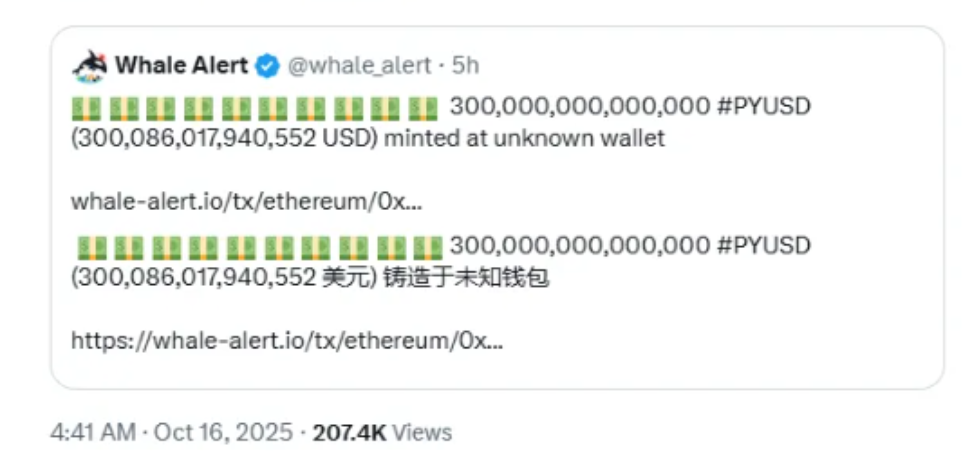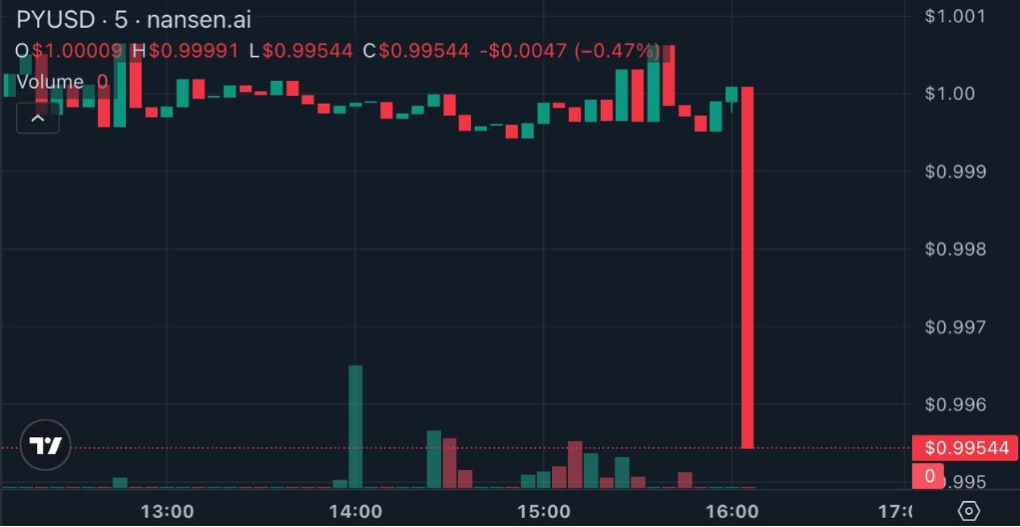22 minutes, 300 trillion dollars, an on-chain phantom that accelerated the heartbeat of the stablecoin market. At 3:12 AM on October 16, the Ethereum blockchain recorded an astonishing transaction: the stablecoin issuer Paxos minted 300 trillion PYUSD. This figure is more than twice the global GDP, enough to buy thousands of Apple companies.
Even more surprising, 22 minutes later, this astronomical amount of stablecoin was completely destroyed. This sudden on-chain operation quickly ignited the cryptocurrency community, raising widespread doubts about the safety and reliability of stablecoins.

01 Overview of the Incident
● The address marked as "Paxos 7" on the Ethereum mainnet interacted with the PYUSD contract, completing a token minting transaction totaling 300 trillion PYUSD.
● This amount was almost beyond anyone's imagination; calculated at a 1:1 peg to the dollar, its value is equivalent to more than twice the total GDP of all countries in the world.
● Just 22 minutes later, this massive PYUSD was sent to an inaccessible burn address, completely disappearing from circulation. This brief on-chain "currency creation" instantly became a hot topic in the cryptocurrency circle.
● Blockchain data shows that Paxos paid only $2.66 in Gas fees for this, yet created tokens worth 300 trillion dollars, highlighting the absurdity of the event.

02 PYUSD Fundamental Analysis
PYUSD is a dollar-pegged stablecoin issued by global payment giant PayPal, managed and issued by Paxos Trust Company. As a fully collateralized stablecoin, PYUSD is pegged 1:1 to the dollar, supported by dollar deposits, U.S. Treasury bonds, and other cash equivalents. Paxos also publishes monthly attestations to provide transparency and comply with U.S. regulatory standards.
Market Position and Growth Trajectory
As of June 2025, PYUSD has become the tenth largest stablecoin, with a market cap exceeding $1 billion, more than doubling from a low of $498 million at the beginning of 2025.
At the beginning of 2024, PYUSD had a market cap of only $234 million, but by August 27, its market cap had surpassed the $1 billion mark. In just over seven months, PYUSD's market cap grew by 327%, showing rapid growth.
This growth is mainly attributed to the high incentive strategy launched for PYUSD on the Solana public chain. In the Solana ecosystem staking project Kamino, the annualized yield for staking PYUSD can even reach over 10%.
| Category | Key Information | Specific Data/Source | Notes/Source | |----------|----------------|----------------------|---------------| | Market Cap and Ranking | Market cap exceeded $1 billion in June 2025 | Approximately $1.01 billion | More than doubled from a low of about $498 million at the beginning of 2025 | | Current Stablecoin Market Ranking | 6th place | Based on DeFiLlama data | | On-chain Distribution and Growth | Significant growth on Solana chain | Share on Solana and Ethereum is approximately 65/35 | Growth in 2025 driven more by strategic initiatives from PayPal and its issuer Paxos | | DeFi Yields (Solana Ecosystem) | Kamino Main Market | Approximately 7% - 13.01% APY | Yields will fluctuate periodically | | Drift Lending Vault | Approximately 10% APY | - | | Drift Insurance Fund | Approximately 18.5% APY | Higher risk | | Save (formerly Solend) Main Pool | Approximately 12% APY | - |
03 Market Reaction and Chain Effects
● According to Nansen data, PYUSD maintained its dollar peg after the incident, with prices only briefly dropping by about 0.5%.

● The cryptocurrency community's reaction to this incident was a mix of shock, concern, and humor. Many observers pointed out that if this 300 trillion PYUSD continued to circulate, its total value would immediately exceed the global money supply by many times.
● The decentralized lending protocol Aave quickly responded by suspending PYUSD trading. Chaos Labs founder Omer Goldberg explained that this restriction was a "temporary measure in response to unexpected large transactions."
● Crypto security researcher yannickcrypto.eth noted that PayPal seemed to have "added the decimal point twice" during minting, leading to the 300 trillion error. He expressed concern over the lack of a "dashboard or multi-signature mechanism" for PYUSD, comparing it to the on-chain limit design of USDC.
04 Industry Background and Deep-seated Risks
This incident exposed potential vulnerabilities in the stablecoin industry regarding internal controls and security mechanisms. Although Paxos quickly characterized the event as an "internal technical error," such a massive amount still raised market concerns about the internal controls of stablecoins.
● Currently, PYUSD ranks sixth in the stablecoin market, surpassing competitors like USDD, TUSD, and FRAX.
● The total market cap of stablecoins has now exceeded $238 billion, demonstrating their increasing use in trading, payments, and as on-chain cash equivalents.
● Unlike stablecoin issuers like Tether, PayPal is already a massive business empire in the Web2 world, with a global user base of 400 million, providing PYUSD with a unique expansion advantage.
05 Regulation and Future Outlook
● At the time of this "phantom transaction" incident, regulators were strengthening oversight of stablecoin accounting and reporting. According to new U.S. guidelines, issuers must maintain real-time proof of reserves and implement strict controls over the creation and destruction of tokens.
● The New York Department of Financial Services (NYDFS) has been made aware of the incident and stated that it is in contact with Paxos and PayPal. This regulatory intervention may lead to stricter audit and control requirements for stablecoins.
● On a positive note, the resurgence of PYUSD in 2025 seems to rely less on ecosystem incentives and more on strategic growth initiatives from PayPal and its issuer Paxos Trust Company.
● In addition to consumer use, PYUSD has also made progress in corporate and institutional payments. In September 2024, PayPal completed its first corporate transaction using PYUSD, when Ernst & Young processed a cross-border payment through SAP's blockchain-supported enterprise system.
Join our community to discuss and grow stronger together!
Official Telegram community: https://t.me/aicoincn
AiCoin Chinese Twitter: https://x.com/AiCoinzh
OKX Benefits Group: https://aicoin.com/link/chat?cid=l61eM4owQ
Binance Benefits Group: https://aicoin.com/link/chat?cid=ynr7d1P6Z
免责声明:本文章仅代表作者个人观点,不代表本平台的立场和观点。本文章仅供信息分享,不构成对任何人的任何投资建议。用户与作者之间的任何争议,与本平台无关。如网页中刊载的文章或图片涉及侵权,请提供相关的权利证明和身份证明发送邮件到support@aicoin.com,本平台相关工作人员将会进行核查。




